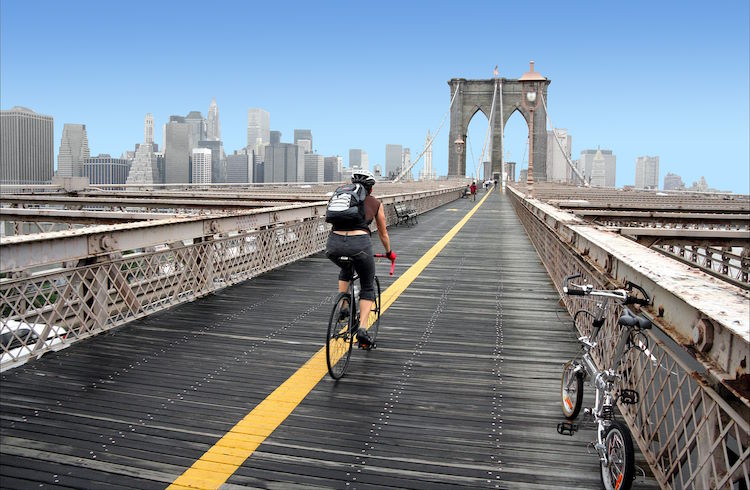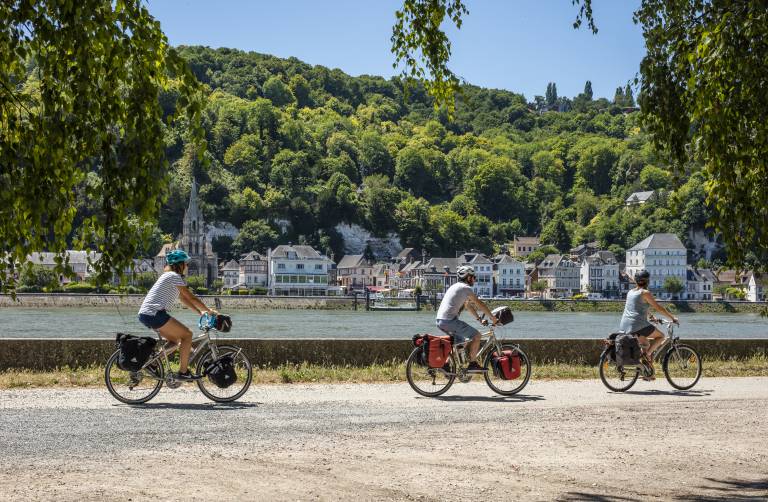Five Destinations That Are Putting Cyclists Ahead of Cars
These global cities are encouraging cycling by investing in bicycle infrastructure. If you like to get around by bike, head to one of these forward-thinking destinations.
 Photo © Getty Images / peterspiro
Photo © Getty Images / peterspiro
Not only are cars incredibly damaging to the planet, as their fuel pollutes the air we breathe, but many people simply can’t afford to own cars so they rely on public transportation and bicycles to get around. Cycling affords flexibility and freedom, where your leg strength (and the condition of your bike, of course) are the only factors limiting you from getting where you need to go.
By making cycling a more accessible option, cities can create a more level playing field where everyone – regardless of whether or not they own a car – can move around the city safely, easily, and in a way that doesn’t harm the environment.
The best-known and most popular example of cycling infrastructure is the cyclist’s beloved bike lane, which comes in many forms. Some lanes are shared with cars, with nothing more than minimal on-street markings, while others are fully separated, protected paths.
Bike lines create a demarcated safe space for cyclists that both encourages more cycling and forces drivers to respect the street space afforded to cyclists. They are a great start to encourage more pedal-powered transportation but they are just that, a start, as they are only one tool in the cycling tool box.
Some cities around the world have made strong investments in education and broader cycling infrastructure that make cycling easier, safer, and more enjoyable. Here are some of the top global destinations that are putting cycling first.
Madison, USA
This small state capital may be known to visitors for its lively nightlife, frequent political rallies, and “forever young” college town vibe but, for locals, it’s also well-known for its love of cycling. Wisconsinites are a hearty bunch, as anyone who lives here needs to put up with brutally cold and snowy winters, including cyclists.
Madison city officials have responded by not only installing bike tools along popular bike routes, but by actually plowing bike lanes in the winter so that cyclists can still ride. Bike lanes often get ignored by snow plows (most of which can’t even fit in them) and it’s especially rare to find a small city footing the bill to plow them. But because Madison lanes are plowed, you’ll see Madisonians riding no matter the weather.
The city has also received one of the coveted few Platinum Bicycle Friendly Community status awards from the League of American Bicyclists. The award was granted as a result of Madison investing in pedestrian and bicycle bridges over major highways, cross-flow bike lanes (bike lanes going in both directions on a one-way street), a citywide Madison BCycle bike share system, bicycle crossing signals at intersections, and an extensive network of bike lanes that connect Madison with surrounding communities.
New York City, USA
The city that never sleeps is one of the best places in the world for cycling, in no small part thanks to the priority the city has placed on cycling infrastructure. While local cyclists (myself included) still complain about how much more could be done (and about the NYPD cops who consistently park in the bike lanes), there is no denying the huge investment the city has made to make cycling safer and easier here. From installing bike lanes – and maintaining them in good condition – to offering free helmet giveaways in the summer, the Big Apple has long prioritized and promoted cycling as a way to stay fit and reduce the city’s famous congestion problem.
New York City has an extensive network of bike lanes across the city, including dozens of large, wide, fully protected bike paths along main avenues. In many cases, entire parking and driving lanes have been eliminated to create space for cyclists, much to the anger of local drivers. New York’s CitiBike bike share program is the largest in the country, with over 26,000 bikes spread across Manhattan, Brooklyn, Queens, the Bronx, and two communities across the Hudson River in New Jersey.
New York’s Department of Transportation also produces highly detailed, extremely useful NYC bike maps each year, which not only plot out all the bike lanes, but also include bike shop information, and have close-ups of difficult-to-navigate bridge crossings.
Utrecht, Netherlands
Surprise, surprise, the Netherlands made the list of most bike-friendly destinations. Many Dutch cities could actually appear on this list (and Amsterdam often gets all the attention, thanks to its many bike lanes and public bike parking options), but Utrecht deserves special mention thanks to its enormous bike parking storage lot. This behemoth of a bike garage, Stationsplein, is the world’s largest, accommodating an astounding 12,500 bicycles. The garage was strategically located near Utrecht Central Station popular public transportation terminal (to further encourage carless transportation) and it’s open 24 hours per day. Best of all, parking is actually free for the first 24 hours, as a way to both encourage its use while also discouraging misuse (using it for permanent storage).
Bogotá, Colombia
Colombia’s cultural and political hub may be known for its history, museums, and street art, but many visitors are surprised to learn how bike-friendly it is. Bogotá is blanketed with about 250 mi (400km) of bike lanes and is extremely proud to be home to Latin America’s oldest and largest Ciclovía ride. Ciclovía, also known as Open Streets, was founded in 1974 and celebrated its 50th anniversary in December 2024. Each Sunday, tens of thousands of cyclists hit the streets to enjoy 75 mi (120km) of car-free lanes in the otherwise congested capital city.
Even if you can’t make the Sunday ride, you’ll find large, well-defined bike lanes (many of which are protected) throughout the city but know that cars are still king here so you’ll want to stay alert while riding.
Either rent a bike from a local shop or borrow one from the city’s brand new bike share system, Tembici. The program launched in 2022 and, with 1,500 mechanical bikes and 1,500 electric bikes across 300 stations, it’s the largest in Latin America. Bringing the whole family? Look out for one of the 150 bikes that comes equipped with a children’s seat!
Paris, France
In late 2021, Paris announced that it would spend $291 million on infrastructure to make the entire city “100% cyclable” by 2026. The city’s impressive Bike Plan details how Paris would gain 112 mi (180km) of new, permanent segregated bike lanes and how it will prioritize infrastructure that will connect the city to neighboring suburbs.
According to a 2024 study, far more people already get around Paris by bicycle than by car. This can cause traffic jams on more popular routes. Additionally, most of the city’s current bike “lanes” are actually just shared spaces with cars and not segregated lanes that are fully separated from traffic. So, this plan is a dramatic improvement.
Also, not only will Paris add 30,000 new metal arches to increase the number of bicycle parking spots from 60,000 to more than 130,000, but 1,000 of these arches will be dedicated to cargo bikes, which many people rely on to transport goods, groceries, and children around town.
Related articles
Simple and flexible travel insurance
You can buy at home or while traveling, and claim online from anywhere in the world. With 150+ adventure activities covered and 24/7 emergency assistance.
Get a quote

No Comments